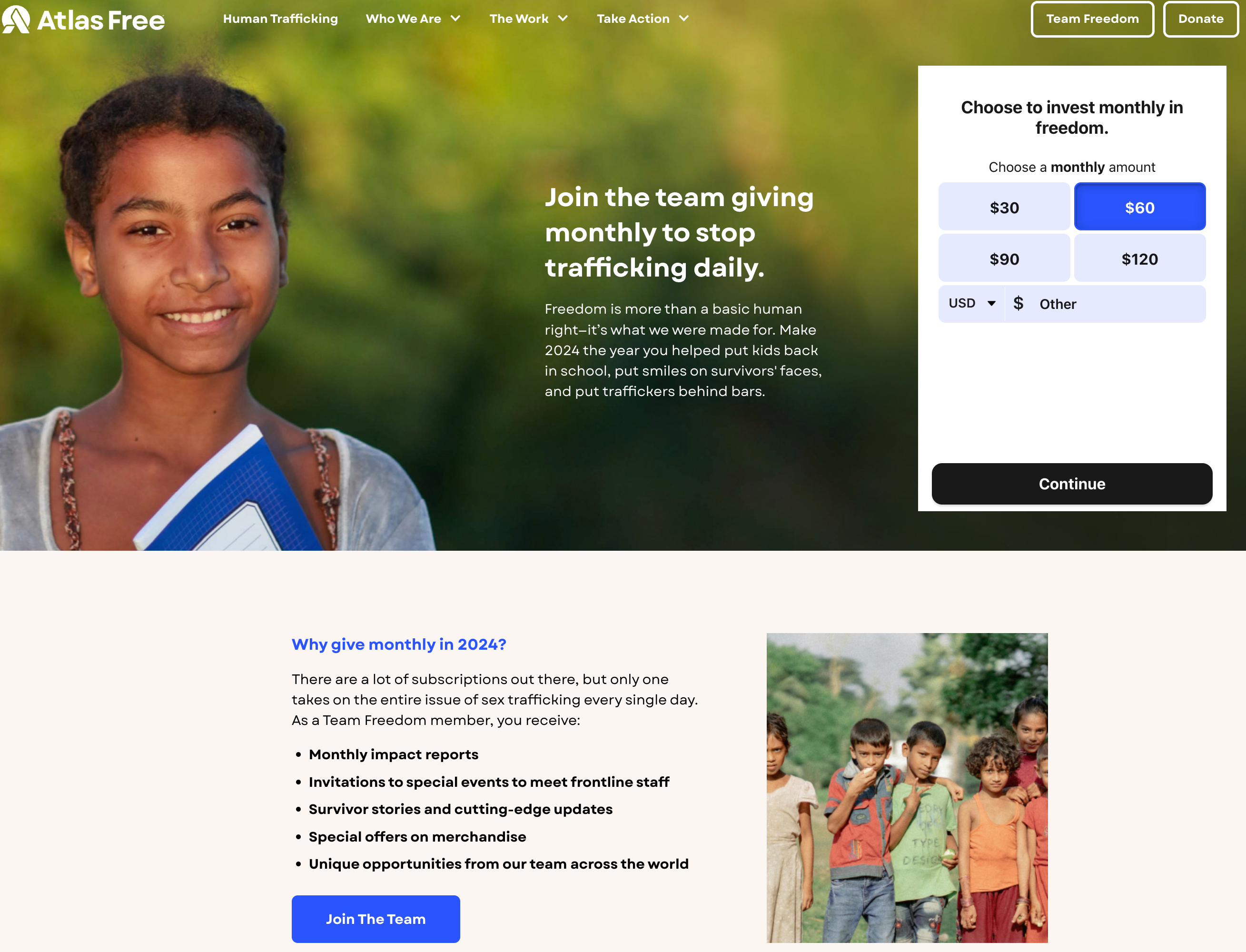How to Evaluate and Upgrade Your Recurring Giving Program [9 Tips]

Most nonprofit organizations know that recurring giving is key to predictable income and organizational growth, but they may struggle to envision a proactive recurring giving strategy. This can lead to feeling stuck.
A successful recurring giving program is the result of cumulative steps over time that build a truly sustainable effort. With that foundation in mind, it’s crucial to evaluate your current efforts and consider how to reach the next step.
Below, we’ll guide you through the process of evaluating your current recurring giving program to find gaps and opportunities for greater fundraising. We’ll also cover how to upgrade your recurring donation program and ways Classy Studio can help.
4 tips to evaluate your current recurring giving program
Recurring giving is a critical part of your overall fundraising strategy. To make the most of it, you need a clear picture of where your current program stands. These tips can help you get started.
1. Define goals for your recurring giving program
To have a successful monthly giving program, you need to know what success looks like for your nonprofit. Goals allow you to plan for growth into the future and provide benchmarks against which you can measure your success.
To help set the right goals, ask questions like:
- How many monthly donors do we want to acquire each year?
- What is our ideal donor retention rate for monthly givers?
- Do we have a revenue goal for our recurring program?
2. Track recurring giving metrics
Gathering data on your current recurring giving program can guide your goal-setting process and demonstrate your recurring giving program’s return on investment (ROI). Below are three key metrics to track.
Monthly recurring revenue (MMR)
MRR is the revenue you can expect to receive each month from your recurring giving program. Lost MRR, also called “churn,” is the monthly revenue you lose when people cancel their recurring gifts.
By tracking these figures, you can set goals for:
- Target total MRR for the year
- Percentage increase in MRR from the previous month, quarter, or year
- Maximum acceptable churn rate
These goals will provide an overview of your program’s success and whether your current investments in it are enough to meet your targets.
Number of active donors
This measure looks at the total number of supporters who make recurring gifts. You can use it to set goals around:
- Target number of supporters to have in your program
- Number of donors by which to grow your program each month, quarter, or year
This measure offers a concrete way of assessing your recurring giving program’s health. Even if you haven’t reached your revenue targets yet, you can see how many people join your movement and how each newcomer might encourage their networks to further the cause.
Recurring gift increases
Over time, you want recurring givers to increase the size of their donations, even if it’s only by a few dollars. Measure this by setting goals around:
- Number and percentage of recurring donors who increase their gift size each year
- Average donation size increase each year
Tracking this helps gauge your audience’s engagement and commitment over time.
3. Pull reports to measure ROI
Once you know what data you need to evaluate your program, it’s time to start running reports to determine the ROI of your recurring giving program.
Using a fundraising solution like Classy from GoFundMe makes this easy. Classy allows you to access custom reports at any time and share them across your team. You can then use these to inform any pivots in your program.
Below are a few of the reports we recommend for evaluating your recurring giving strategy:
- Returning one-time donors: This report allows you to see donors who have given more than one donation to your organization. These supporters will likely be more responsive to targeted outreach encouraging them to become recurring donors.
- Failing recurring giving plans: This report allows you to quickly review any recurring donations that had unsuccessful transactions. Use this information to reach out to donors to remedy payment issues and keep their membership active.
- Recurring plans over one year: This report shows you recurring donations that have been active for at least a year. Use it to evaluate your recurring donor retention rate and identify potential candidates to approach for a slight increase in their contributions.
- Upcoming expiring recurring plans: This report allows you to see existing donors with upcoming credit or debit card expirations before they happen. Avoid unplanned churn by reaching out for updates and thanking them again for their ongoing support.
4. Audit your recurring giving processes
Your donation process needs to be smooth and provide the right incentives to supporters. Discuss with your team how you communicate with recurring donors, what stewardship efforts you employ, and what incentives you believe will most appeal to your target audience. These elements can impact supporters’ engagement and retention over time.
Here are several questions to consider:
- Do you have consistent appeals throughout the year?
- Is there a special day or event that could serve as an opportunity to ask for recurring donations?
- Do you have a recurring donor prospect list?
- How do you engage your recurring donors?
- How often do you check in with them?
- How do you recognize them?
- How do you reinforce what their dollars help you accomplish?
- What donor management tools do you use to automate regular touchpoints?
4 strategies to upgrade your recurring giving program
It’s critical to continue refining your recurring giving program to attract, convert, nurture, and retain new donors. Let’s explore four strategies to consistently raise more every month.
The ultimate recurring giving playbook1. Create a dedicated campaign page
To grow monthly contributions to your nonprofit, the recurring giving option must be highly visible. This option should be on all online donation forms. You may also want to include a unique donation button on your nonprofit website that links to a dedicated recurring giving donation page.
On your monthly giving landing page, build a strong brand that increases your program’s credibility and memorability. Instead of calling it your “monthly giving program,” consider a unique program name that fosters brand loyalty and a sense of community and belonging among supporters. This can be something that ties in with your specific cause or something more general like the “Circle of Givers.”
On your branded recurring donation page, you can also include:
- Value statements on why donors should give monthly
- Member and beneficiary testimonials about the power of recurring giving
- Social proof data, such as the number of monthly donors, average monthly gift, or a list of founding monthly donors
- Impact statistics about your nonprofit’s initiatives funded by recurring donors
Branded recurring giving programs in action
Atlas Free, a nonprofit working to accelerate and resource the fight against sex trafficking and exploitation, calls its monthly giving community “Team Freedom” and uses Classy to create an inviting recurring donor experience that encourages more sign-ups. With Classy’s in-line donation forms, Atlas Free can offer a seamless giving journey with its brand and website and has full control over copy and imagery.

2. Quantify the impact of recurring gifts
Just like one-time gifts, use impact blocks to help pair outcomes with different monthly donation amounts. For example, a food bank could highlight how many families it can feed for $10, $20, $50, and $100 per month. This helps monthly givers understand the tangible difference they’ll make at different giving levels.
You can also highlight the lifetime value of recurring donors’ support. Remind them that a $30 monthly donation adds up to $360 over the course of the year to help make the giving option feel more accessible.
3. Appeal to younger generations
Subscription giving offers a great opportunity to engage Gen Z donors. Not only are they accustomed to subscription experiences (like Spotify, Amazon, and Netflix), but they’re also earlier in their income-earning years.
Gen Z supporters may not be ready to make a $500 annual gift, but smaller recurring contributions fit more easily within their budgets and open the door to future stewardship.
To ensure that your recurring giving program appeals to this donor base, consider these tips:
- Prioritize your social media presence: GoFundMe’s The Social State of Giving report found that 46% of Gen Z believes people should share their donations online to help spread the word and inspire others. Mobilize them with the right tools to execute this by making appeals through social media and encouraging them to share their participation.
- Emphasize the power of smaller gift sizes: A branded recurring giving program specifically for younger donors, like a “Coffee Club,” invites them to swap one morning latte a month for a $5 recurring donation to your nonprofit.
- Optimize your mobile giving experience: Research shows that Gen Zers spend over six hours per day on their smartphones. Ensure your organization’s website and donation form are optimized for mobile use to meet these donors where they’re most likely to give.
Low-barrier giving options in action
Tunnel to Towers Foundation, a nonprofit that honors military and first responders, wanted an easy way to drive traffic across multiple channels to its recurring program. Using Classy, it launched a recurring donor program that encourages supporters to give $11 a month in honor of 9/11. This low barrier to entry means anyone can join the cause and contribute to making a significant impact on its mission.
As the nonprofit’s senior vice president of marketing and communications explains, “For a small amount of money, they’re helping to pay off the mortgages of American heroes.” The result is powerful: Most of the nonprofit’s online donations come from recurring gifts, and it acquires thousands of new recurring donors per month.
4. Provide preferred payment methods
Classy’s Why America Gives report found that 20% of donors reconsidered making a gift when their preferred payment method was unavailable. Providing preferred payment options on your giving page creates a seamless experience that increases conversions.
Nonprofits can implement modern payment processes through solutions like Classy Pay, inviting recurring supporters to give via credit cards, ACH bank transfer, digital wallets, PayPal, Venmo, and more.
Classy Pay in action
Alight, a nonprofit working for and with communities displaced by conflict, climate change, and social and economic exclusion, decided to try face-to-face canvassing to acquire new recurring donors. The nonprofit processed donations using Classy Pay alongside seamless integrations with other tools designed for in-person donor acquisition through the Classy API.
This approach provided the Alight team with real-time visibility into new recurring gifts and enabled precise and up-to-date reporting. It also kept the donation process quick (only a few minutes) for supporters with preferred payment methods. The campaign brought in 660 new recurring donors and raised $53,000, meeting its acquisition goals two months early.
Our message really resonated well with the audience. The process to become a new recurring donor on Classy was so quick that we met our goals much faster than we thought we would.
How Classy Studio takes recurring giving to the next level
Customizing your giving experience for recurring donors has never been easier with Classy Studio. Make your brand shine and drive long-term value through your monthly giving campaign pages with several user-friendly features, such as the ability to:
- Adjust your default donation widget settings to recurring and decide if you want to disable one-time donations entirely.
- Offer monthly donations and membership campaigns with an annual gift option.
- Show different levels of giving with impact titles and customize them to specific program designations or have all recurring donations go to unrestricted funds.
- Use Embedded Studio to apply customizable nudges for recurring donations. These animated prompts appear under set circumstances, encouraging supporters toward the action you want them to take.
Studio’s enhanced email marketing capabilities also extend a personalized experience for recurring donors after they complete a gift. Nonprofits can:
- Send customized emails with the same drag-and-drop functionality used to build campaigns.
- Add a login, Manage Donation, or Update Payment button for supporters to quickly review their recurring gift membership.
- Add layouts with various sections and images that link back to education about your cause.
Evaluate and scale your recurring giving program for greater impact
No matter the current state of your recurring giving program, you can take steps to level it up and continue to grow it over time. Perform a pulse check on where your program currently stands and draft up a plan on how you can incrementally improve your results.
The stepping stones above are great for guiding an annual or quarterly review process and will help you build a sustainable and predictable recurring giving campaign for your cause.
Copy editor: Ayanna Julien

The ultimate recurring donation platform



